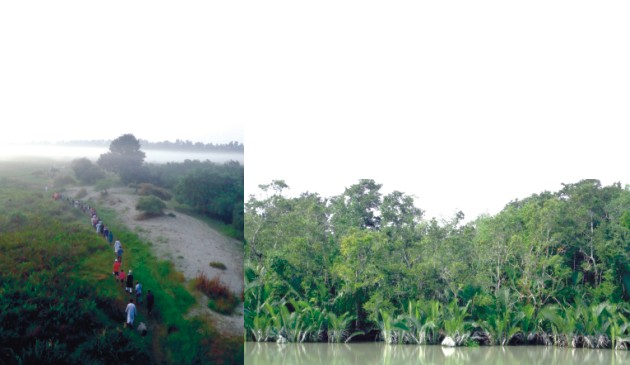| Home - Back Issues - The Team - Contact Us |
 |
| Volume 10 |Issue 10| March 11, 2011 | |
|
|
Travel Into the Wild AANTAKI RAISA
Sundarbans, the largest mangrove forest proudly standing at the South-Western delta of Bangladesh, is home to a legendary collection of wild creatures, gipsy fishermen, brave honey-collectors, dangerous yet appealing greens and a mesmerising mingle of rivers and the Bay of Bengal. A trip to this land is a trip to breath-taking adventure and awe-inspiring witness to the mystic nature. Imagine yourself sitting on the deck of a boat sailing through a serpentine river, with deep, mysterious forest on the both sides, no matter how hard you try to see in front or behind your boat, there's just the infinitely flowing river; imagine waking up to the chirping wild birds in the morning and sleeping to the wild symphony of the roaring unknown animals; imagine being seduced by the fleeing herd of beautiful deer or thrilled by the foot prints of a Royal Bengal Tiger; imagine being surprised by bumping into a village full of friendly fishermen in the extreme depths of the forest and then loosing yourself into the ferocious waves of the Bay of Bengal; if you have been successful in imagining all of it then welcome to the Sundarbans – a promising candidate to be the greatest natural wonder of the world, the natural habitat of the rare and majestic Royal Bengal Tigers and a land of many more amazing facts that are about to be revealed. The name Sundarban, though literally means “beautiful forest”, is believed to be derived from the Sundari trees that are found in the Sundarbans in large numbers. The Sundarbans are the largest littoral mangrove belt in the world, stretching 80 km into the Bangladeshi hinterland from the coast. The forests aren't just mangrove swamps though; they include some of the last remaining stands of the mighty jungles which once covered the Gangetic plain. The forest covers 6,000 square kilometres of Bangladeshi land bounded within Bagerhat, Khulna and Sathkira districts in the North, Bay of Bengal in the South; Baleswar (or Haringhata) river, Perojpur, Barisal district in the East, and Raimangal and Hariabhanga in the West, sharing boundaries with the West Bengal. The forest lies in the vast delta on the Bay of Bengal formed by the super confluence of the Padma, Brahmaputra and Meghna rivers. It became a UNESCO world heritage site in 1997. One third of Sundarban's landscapes is covered under water. Hundreds of rivers and canals are scattered like spider webs throughout the jungle and any spot can be accessed by water transports. It takes at least three days to cover the major tourist points in the Sundarban and hence a boat trip for three days itself is an exciting experience. There are several forest stations where you can stop by and feel the essence of living inside a jungle. During your sail, you might see a wild pig swimming across the river or a few crocodiles slithering on the silt by the river bed. The Sundarban is a nice place to observe various kinds and colours of birds; especially at the sunset you can see wild birds flying in flocks, creating colourful spots on the sun while crossing it. If you can time your trip properly and anchor on a tourist spot early in the morning, you will have the golden opportunity to witness hundreds of spotted deer eating the leaves from the Keora trees and then running away being aware of the presence of human. And of course, our ape cousins- the monkeys, will always be there to tease you and entertain you with their expressions and amazingly athletic skills on the trees. Though there are around 400 Bengal Tigers roaming around the depths of the Sundarbans, you have to be extremely lucky to have a glimpse of one. One might be sailing in the Sundarbans for 20 years and never meet the mighty beast; but there are also the gifted ones who get to see this rare species even on their very first visit. If you travel South, you will find yourself in the confluence of the three major rivers of Bangladesh with the Bay of Bengal. The wild waves will swing your boat in a wilder rhythm and you will feel no less than the adventurous Sindbad. At the very South of the jungle, by the Bay of Bengal, you will find the villages of the fishing families. If you can stay a night or two by the village, you can enjoy the delicacy of fresh and unadulterated fish or the popular dried fish curries. You will see yards after yards filled with dried fish spreading its exotic and sharp smell like a jungle fire. If you can manage to visit in December, do plan your trip so you can enjoy the Raash Pooja celebrated by the Hindu community in the island Alor Kol in Dublar Chor. The village arranges a fair for the occasion where most of the decorations are done using dried and coloured fish; this fair, named the Raash Mela (the Raash Fair) is one of a kind, held under the full moon by the sea and a must-see in the Sundarbans. Several spots in the jungle have high towers to provide the visitors with an aerial view of the jungle around. Guided tours also offer trekking into the jungle; which is daring yet safe as there are armed guards with any and every tourist party in the jungle. On your way back to the port due North, you can make a stop at Karamjal, where the government has built an animal sanctuary and safari; if you miss seeing any of the wild specialties of the Sundarbans, you can see them here. Famous Spots How to go
Copyright
(R) thedailystar.net 2010 |
